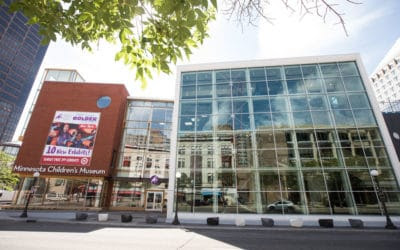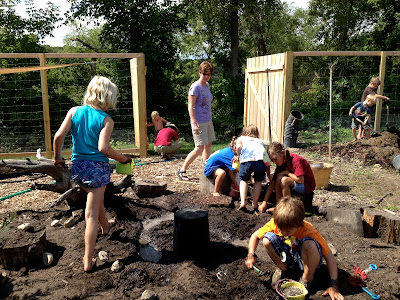 |
| Photo credit: Minnesota Children's Museum |
In reviewing a big museum project, we tend to review the building, a new wing and the exhibitions. At the top of the review is the project cost, facility square footage, the number of new galleries, new acquisitions, major donors, and sponsors. Depending on the project, the design team, architects and exhibit designers are mentioned.
On June 7th,
Minnesota Children’s Museum cut the ribbon and opened its doors to a major
renovation and expansion. Its $30 million campaign, Room To Play, launched in 2011 helped grow the building from 65,000
to 74,000 square feet. The makeover represents 35% more space for visitors. The Museum
is, as billboards, bus sides, its website, and Facebook page announce, Bigger,
Better, Bolder.
 |
| Imaginopolis is created and recreated countless times each day. |
There added amenities, from a skyway-level entrance, café and coffee bar; more bathrooms; more seating, and a kitchenette in Sprouts. An easier entry experience through the parking-connected skyway and another elevator improve circulation. On my two visits prior to opening and at the ribbon cutting ceremony, I noticed crowds move easily through the spaces, bigger kids as part of family groups, natural light filling more areas of the Museum, and a beautiful space that someone described as a part art museum and part place for play.
Deeper, Less Visible Growth
While all
new exhibits, and expanded footprint, and more amenities attest to Bigger,
Better, Bolder, MCM has accomplished more than that. The deeper, less visible
ways MCM has grown count in the long run.
From the
start, it was clear that a major expansion of the building was going to be
challenging. In 1995 I was head of exhibits and education at MCM when the
Museum re-located to a new building in downtown St. Paul. The site was small
with limited space for physical growth, but the new 65,000 s.f. building easily
accommodated the 350,000 visitors who came the first year–doubling previous
attendance.
Over the
years, attendance climbed to regularly surpassing 450,000 visitors annually at
the downtown St Paul location. It became apparent that something needed to be
done to ease the crowding. Opportunities for expansion had been designed into
the original building: adding a floor, building into the small side yard and filling in the street-front setback, and filling in a mezzanine level. But the
building was virtually landlocked.
 |
| Moving through new spaces, an adventure and better circulation |
While
every major project is an opportunity to grow institutional value and physical
presence, physical growth, a new building or wing, usually wins out–and not
necessarily with the best results. Growing
value involves going to the core, remembering and reconnecting with what is
fundamental, staying true to the audience. Growing value relies absolutely on
paying attention to what is necessary but invisible.
Even as the
Museum conducted a capital campaign and worked with its architects MSR Design and exhibit planners, Gyroscope, Inc. (on whose team I served), it directed resources
thoughtfully and from the beginning to institutional growth.
Throughout
the process, MCM invested where its visitors would benefit directly from the
expansion and renovation: 35% more space for visitors and more amenities. To go
deeper into the structure of its value, the Museum also studied itself, its
audience, and its stakeholders. By the grand re-opening, MCM's extensive platform around the power of play had brought on friends, leaders, and the community as its partners.
My folder
with the studies MCM conducted to guide expansion is thick and interesting to
look at in retrospect. “Inspiring Future Growth” summarizes the results of a
questionnaire to over 900 parents of children in the age range. A “clicker”
study analyzed traffic, space usage, tickets, and attendance in 2011 and compared it to a 2004 study. A white paper summarized research on play and learning. The Museum
also conducted a survey on play with its members. A focus area assessment explored
perceptions of the Museum’s learning value. A brand study, stakeholder
engagement audit, and technology scan round out the set of studies. The Museum has
generously shared some of these studies on their website.
The
Museum diligently used its planning time to plumb its foundational thinking
and, in the process, I believe, internalized its core purpose to a significant new
degree.
Sparking children’s learning through play, the Museum’s mission, could have been a catchy slogan with a new look for the reopening. Instead, the Museum engaged in a sustained investigation around play. Drawing on research on the value of play, the Museum connected why play matters with skills that are crucial to children’s learning, well-being, social interactions, and creativity. Dubbed the Seven Powers of Play, opportunities to practice skills such as creative thinking, collaboration, and communication were deliberately incorporated into design, activities, and material selection, and messages. The 7 Powers of Play are posted through out the galleries.
 |
| Play to the 7th power |
Sparking children’s learning through play, the Museum’s mission, could have been a catchy slogan with a new look for the reopening. Instead, the Museum engaged in a sustained investigation around play. Drawing on research on the value of play, the Museum connected why play matters with skills that are crucial to children’s learning, well-being, social interactions, and creativity. Dubbed the Seven Powers of Play, opportunities to practice skills such as creative thinking, collaboration, and communication were deliberately incorporated into design, activities, and material selection, and messages. The 7 Powers of Play are posted through out the galleries.
An intentional approach also brought parents and
caregivers to the forefront. Parental adults have a key role in encouraging
children’s play and exploration. Their interests and comfort must be provided
for whether through seating, restrooms, or anticipating their reactions to play’s mess or a
lack of structured experiences. While the novelty and ambiguity of
spaces, materials, and structures may invite playful exploration, they also can
create uncertainty and hesitation for adults and for children about how to get started. Full-scale prototypes of Creativity Jam in 2013 and 2015 and Forces at Play in
2016 took on some of these challenges, testing engagement strategies for adults,
messaging, and staff prepared to facilitate free-choice, open-ended play
experiences.
The
Museum’s comprehensive view of play and its value has been adapted to messages
for multiple audiences and across platforms using a friendly, engaging tone.
#PlayMoreMN invites members and visitors to post their stories and photos of
powerful play that it has defined as captivating and fun,
active and challenging; self-directed and open-ended. Tips on Let’s Play helps parents and caregivers enhance the learning that occurs through children’s
play. Successful People Play videos profile how leaders, friends, educators, artists, and chefs in Minnesota play. Since opening the Museum has also launched Stand Up for Play, a community
campaign to make play a priority.
While the Museum has been for and about play since its founding more than 35 years ago, over the last seven years it has become an advocate and a leader for play. And it shows. MCM President and CEO, Dianne Krizan, encouraged creativity by letting children play in her recent Commentary in the Star Tribune. A joyous spirit of play also shows throughout the Museum as children paint their faces, spiral down the slide, transform a light-filled landscape, set off a chain reaction, wash a vehicle with bubbles, and build forts, and discover the possibilities of play.
Way to
go, Dianne, Barbara, Jess, Jennifer, Mary, Kirstin, Joe, Blake, Michelle, Bob, and so many more!








